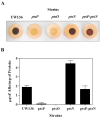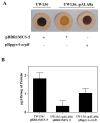The unphosphorylated EIIA(Ntr) protein represses the synthesis of alkylresorcinols in Azotobacter vinelandii
- PMID: 25642700
- PMCID: PMC4314083
- DOI: 10.1371/journal.pone.0117184
The unphosphorylated EIIA(Ntr) protein represses the synthesis of alkylresorcinols in Azotobacter vinelandii
Abstract
Upon encystment induction, Azotobacter vinelandii produces the phenolic lipids alkylresorcinols (ARs) that are structural components of the cysts. The enzymes responsible for the ARs synthesis are encoded in the arsABCD operon, whose expression is activated by ArpR. The transcription of arpR is initiated from an RpoS dependent promoter. The nitrogen-related phosphotransferase system (PTS(Ntr)) is a global regulatory system present in Gram negative bacteria. It comprises the EI(Ntr), NPr and EIIA(Ntr) proteins encoded by ptsP, ptsO and ptsN genes respectively. These proteins participate in a phosphoryl-group transfer from phosphoenolpyruvate to protein EIIA(Ntr) via the phosphotransferases EI(Ntr) and NPr. In A. vinelandii, the non-phosphorylated form of EIIA(Ntr) was previously shown to repress the synthesis of poly-ß-hydroxybutyrate. In this work, we show that PTS(Ntr) also regulates the synthesis of ARs. In a strain that carries unphosphorylated EIIA(Ntr), the expression of arpR was reduced, while synthesis of ARs and transcription of arsA were almost abrogated. The expression of arpR from an RpoS-independent promoter in this strain restored the ARs synthesis. Taken together these results indicate that unphosphorylated EIIA(Ntr) negatively affects activation of arpR transcription by RpoS.
Conflict of interest statement
Figures






Similar articles
-
Unphosphorylated EIIANtr induces ClpAP-mediated degradation of RpoS in Azotobacter vinelandii.Mol Microbiol. 2017 Apr;104(2):197-211. doi: 10.1111/mmi.13621. Epub 2017 Feb 6. Mol Microbiol. 2017. PMID: 28097724
-
GacA regulates the PTSNtr-dependent control of cyst formation in Azotobacter vinelandii.FEMS Microbiol Lett. 2017 Jan;364(2):fnw278. doi: 10.1093/femsle/fnw278. Epub 2016 Dec 8. FEMS Microbiol Lett. 2017. PMID: 27940465
-
Enzyme I NPr, NPr and IIA Ntr are involved in regulation of the poly-beta-hydroxybutyrate biosynthetic genes in Azotobacter vinelandii.J Mol Microbiol Biotechnol. 2008;15(4):244-54. doi: 10.1159/000108658. Epub 2007 Sep 20. J Mol Microbiol Biotechnol. 2008. PMID: 17878711
-
Regulation of nitrogen fixation in Klebsiella pneumoniae and Azotobacter vinelandii: NifL, transducing two environmental signals to the nif transcriptional activator NifA.J Mol Microbiol Biotechnol. 2002 May;4(3):235-42. J Mol Microbiol Biotechnol. 2002. PMID: 11931553 Review.
-
The bacterial phosphoenolpyruvate:carbohydrate phosphotransferase system: regulation by protein phosphorylation and phosphorylation-dependent protein-protein interactions.Microbiol Mol Biol Rev. 2014 Jun;78(2):231-56. doi: 10.1128/MMBR.00001-14. Microbiol Mol Biol Rev. 2014. PMID: 24847021 Free PMC article. Review.
Cited by
-
LEA proteins are involved in cyst desiccation resistance and other abiotic stresses in Azotobacter vinelandii.Cell Stress Chaperones. 2017 May;22(3):397-408. doi: 10.1007/s12192-017-0781-1. Epub 2017 Mar 3. Cell Stress Chaperones. 2017. PMID: 28258486 Free PMC article.
-
The GacS/A-RsmA Signal Transduction Pathway Controls the Synthesis of Alkylresorcinol Lipids that Replace Membrane Phospholipids during Encystment of Azotobacter vinelandii SW136.PLoS One. 2016 Apr 7;11(4):e0153266. doi: 10.1371/journal.pone.0153266. eCollection 2016. PLoS One. 2016. PMID: 27055016 Free PMC article.
-
The stringent response regulates the poly-β-hydroxybutyrate (PHB) synthesis in Azotobacter vinelandii.PLoS One. 2024 Apr 4;19(4):e0299640. doi: 10.1371/journal.pone.0299640. eCollection 2024. PLoS One. 2024. PMID: 38574051 Free PMC article.
-
Azotobacter vinelandii as a Nitrogen-Negative Chassis for Bio-Oil and Bio-Wax Production of Heterologous and Native Lipids.Microbiologyopen. 2025 Aug;14(4):e70047. doi: 10.1002/mbo3.70047. Microbiologyopen. 2025. PMID: 40820660 Free PMC article.
-
Expression of the sRNAs CrcZ and CrcY modulate the strength of carbon catabolite repression under diazotrophic or non-diazotrophic growing conditions in Azotobacter vinelandii.PLoS One. 2018 Dec 13;13(12):e0208975. doi: 10.1371/journal.pone.0208975. eCollection 2018. PLoS One. 2018. PMID: 30543677 Free PMC article.
References
-
- Segura D, Vite O, Romero Y, Moreno S, Castaneda M, et al. (2009) Isolation and characterization of Azotobacter vinelandii mutants impaired in alkylresorcinol synthesis: alkylresorcinols are not essential for cyst desiccation resistance. J Bacteriol 191: 3142–3148. 10.1128/JB.01575-08 - DOI - PMC - PubMed
Publication types
MeSH terms
Substances
LinkOut - more resources
Full Text Sources
Other Literature Sources

